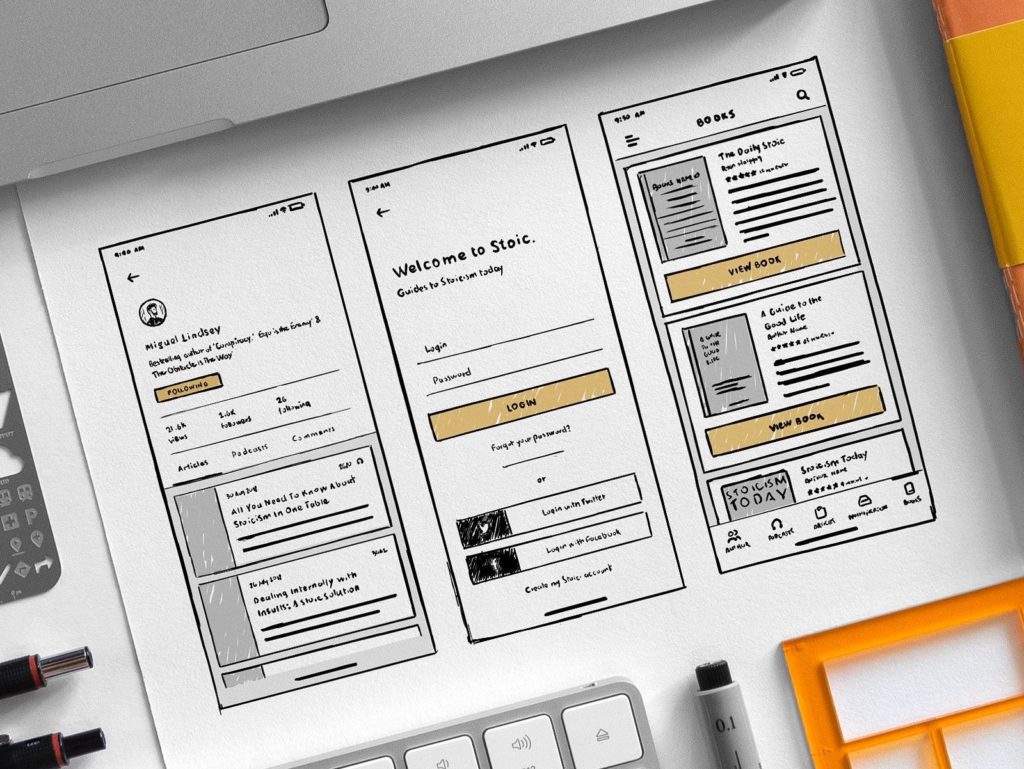
How to make a rapid prototype for mobile apps?
Table of Contents
If you’re wondering how to make a rapid prototype for mobile apps, this article is for you. Read on to learn what rapid prototyping is, what its key benefits are, and how to create a prototype for your mobile app using the most productive industry best practices.
What is rapid prototyping?
Agile and lean development methodologies have developed the technique of rapid prototyping to reduce the time it usually took teams to come up with click-through prototypes of digital products.
The idea behind rapid prototyping is to build an early version of the product to validate the business idea and gather essential user feedback as early as possible. Instead of dedicating dozens of hours to develop a prototype, agile teams use prototyping tools to quickly create multiple click-through prototypes that offer different flows to be tested by users.
Rapid prototyping allows teams to gain lots of time for taking in feedback, discussing, iterating, and re-testing the updated prototype step by step.

Read also: Native app vs. hybrid app. Which one you should choose?
Why should you make a rapid prototype for mobile apps?
Prototyping an app is the best method for saving money on app development. By creating a rapid prototype for mobile apps, you get to enjoy the following benefits:
- You can share your idea with users, colleagues, co-founders, or even investors.
- Prototypes help to accelerate the development process (and saving you money). By showing a “ready-to-code” mockup or prototype to the development team, you’ll make their life easier.
- The same is true for the design process. By sharing a “ready-to-design” wireframe or mockup with the designer, you’ll save time and money on having that designer create it from scratch.
- Rapid prototypes help to validate business ideas by allowing you to gather customer feedback early one. It’s enough to provide users with a ready-to-use UI, and you’ll get plenty of valuable insights.
- Rapid prototyping doesn’t require any technical skills. You don’t need to be a software developer or UX designer to create a prototype of your app. Tools like Sketch, Invision or Marvel help to create and connect app views, and even animating UI to create an accurate mockup of your mobile app.
Now that you know why rapid prototyping is advantageous to mobile app development, here’s a step by step guide to help you create a prototype for your app.
How to make a rapid prototype for mobile apps – a step-by-step guide
Step 1 – Develop and refine your idea
To create a successful mobile app, you need to make sure that it solves the problem of your target audience in the best possible way.
This step might seem basic, but you’d be surprised how many people decide to create an app just because their idea seems cool. That’s just not enough for building app users will need, download, use actively, and share with their friends, family, and colleagues.
For example, if you’re planning to develop an app that helps users create to-do lists, you need to have a clear idea about what kind of problem the core of your app solves. How is it different from similar apps? Does it offer any extra functionalities or integrations with other applications? Does it have a captivating interface?
The best apps are created by people who have identified a problem and decided to fix it.
Experienced software development companies will take you through a process that helps to discover the purpose of the app, understand your key competitors, and learn more about the industry.
Step 2 – Brainstorm product requirements
Once you identify the problem your app solves, it’s time to create a list of product requirements – which is just another word for app features.
Start by creating a list of features your ideal app should have. Then decide which ones will form the core of your app. You need to prioritize features according to the needs and preferences of your target audience. Divide features into must-haves and nice-to-haves. Take the first 3-4 features on your priority list and create a prototype with them in mind.
Even the most popular apps like Instagram started out simple. As your app gains traction and you learn that users want your app, you can invest in it to add more features and expand its functionality.
Step 3 – Create sketches of your app’s primary screens
Now it’s time to consider the user experience (UX) of your app. Start by sketching the primary screens of your app. This will help you organize the app’s features visually. Once your sketches are ready, you can start building on these screens and adding details. Also, your initial sketch will already consist of one potential user flow you can keep on refining as you develop your app.
Step 4 – Transform sketches into wireframes
The next phase in developing your prototype is wireframing. A wireframe is a simplified outline of your product. It’s usually based on simple elements like boxes, words, and lines. It’s smart to add some descriptions to communicate your concept better. The idea behind wireframing is to create a framework that sets the direction for your app – not creating its final look.

Step 5 – Create a prototype
Now it’s time to use your wireframes for creating a prototype. You can put them together to create a basic prototype or use specialized tools that help to transform the initial idea into interactive prototypes. These tools allow building prototypes that look and feel just like real apps with the help of fake content.
Read also: Why you should invest in a mobile app for business?
Best practice of rapid prototyping for mobile apps – Design Sprint
One of the most rewarding prototyping tactics is the Design Sprint. A Design Sprint is a process that takes five days, where each day is dedicated to answering key business questions through planning, design, prototyping, and testing the idea with users. This business strategy is encapsulated into a short process to help teams quickly design and test new ideas.
Here’s what the Design Sprint looks like:
- Day 1: Mapping out the problem and identifying the area of focus.
- Day 2: Sketching different solutions on paper and brainstorming.
- Day 3: The team creates the final sketch and turns ideas into a testable hypothesis.
- Day 4: The team develops a high-fidelity prototype.
- Day 5: Testing the prototype with users to gather feedback and insights.
Thanks to the Design Sprint method, teams can take a shortcut through the design and prototyping process that often ends up in endless debates. By focusing on one task each day, team members can compress months of work into a single week. Instead of launching a Minimum Viable Product (MVP) to check if your business idea works, you can get clear insights from a realistic prototype. As a result, you’ll fast-forward into the future and see customer reactions to your product before investing in building a full-fledged mobile app.
Key takeaway
Rapid prototyping is one of the best strategies for developing successful digital products. Used by enterprises and startup founders, prototypes offer an unparalleled opportunity for validating a business idea and learning whether it works in a matter of weeks.
Are you looking for a team of mobile development experts to create a prototype of your app? Get in touch with us; we take our clients through the prototyping process and help them at every step of the way.